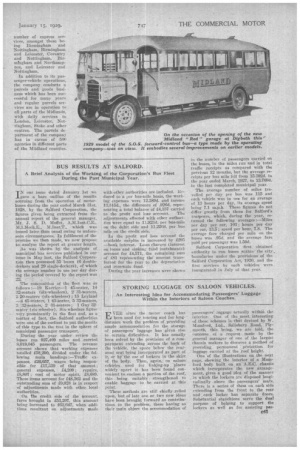BUS RESULTS AT SALFORD.
Page 25

If you've noticed an error in this article please click here to report it so we can fix it.
A Brief Analysis of the Working of the Corporation's Bus Fleet During the Past Municipal Year.
TN our issue dated January 1st we .1gave a bare outline of the results accruing from the operation of motorbusea during the year ended March 31st, 1928, by the Salford Corporation, the figures given being extracted from the annual report of the general manager, Mr. J. S. D. Moffet, A.M.Inst.C.E., M.Inst.T., which was issued later than usual owing to unforeseen circumstances. In fulfilment of the promise we then Made, we now propose to analyse the report at greater length.
As was -shown by the analysis of municipal bus services published in onv issue in May last, the Salford Corporathin then possessed 35 -buses (6 doubledeckers and 29 single-deckers), of which the average number in use per day during the Period Covered by the report was
22. • The composition of the fleet was as follows ;-19 Karrier—I 454eater, 14 32-seaters '(six-wheelers), 2' 31-seatets,
2 20-seaters -(six-wheelers) ;-15 Leyland 45-Seaters, 1 43-seater, 5 33-seaters, 3 :32iteaters, 2 -31-seaters ; 1 Guy 32seater (six-wheeler). Six-wheelers -figure very prominently in the fleet and, as a matter of fact, the Salford authorities were One of the earliest to put the merits of this type to the test in the sphere of municipal passenger transport.
During the year under review the ran 927,409 miles and carried 8,019,045 passengers. The revenue account shows that working expenses totalled £58,290, divided under the following main headings :—Traffic exnenses, £26,657, wages being responsible for £17,339 of that amount ; general expenses, £4,209; repairs, £8,807; cost of motor spirit, £8,689. These items account for £48,362 and the outstanding sum of £9,928 is in respect of adjustments made with other local authorities.
On the credit side of the account, fares brought in £53,207, this amount being increased to £62,647, when additions resultant on adjustments made
with other authorities are included. Itedueed to a per bus-mile basis, the working expenses were 12.389d. and income 1.3.315d., the difference of .926d. representing a total balance of £4,357 carried
to the profit and loss account. The adjustments effected with other authorities were equal to 11.923d. per bus-mile on the debit side and 11.226d. per bus mile on the credit side.
In the profit and loss account the available .surplus is increased by £295 —bank interest. Loan charges (interest on loans and sinking fund instalments) account for £4,571, the remaining sum
..£81 representing the' amount transferred for the Year to the depreciation and renewal fuud.
During the year increases were shown. in the number of passengers carried on the buses, in the miles run and in total traffic receipts as compared with the previous 12 months, but the average receipts per bus mile fell from 15.392d. in the year ended March, 1927, to 13.769d. in the last Completed municipal year.
The average number of miles travelled per day. per bus was 115 and each vehicle was in use for an average of 13 hours per day, its average speed being 7,1 m.p.h. These figures do not differ greatly from those for Salford's tramcars, which, during the year, returned the following averages
Per day per car, 103; hours per day per car, 12.5; speed per hour, 7.8. The average fare charged per mile on the husea was .95d. and the average fare paid per passenger was 1.59d.
Salford Corporation first obtained authority to run buses withinthe city boundaries under the provisions of the Salford Corporation Act, 1920, and the firat services by such vehicles were inaugurated in „July of that year.
































